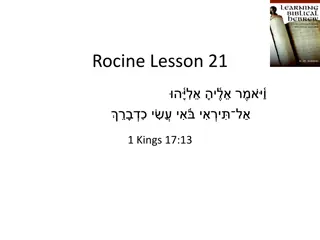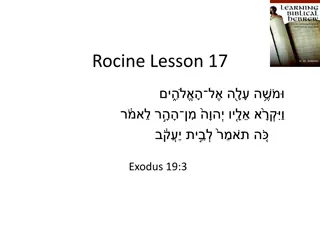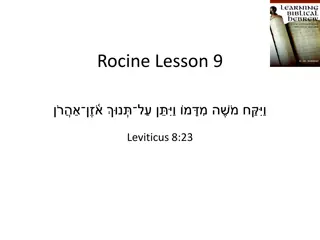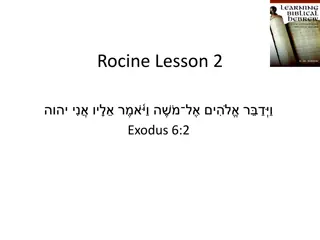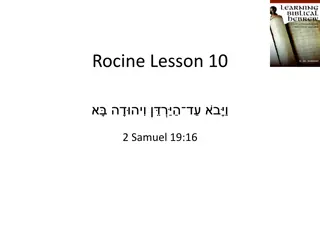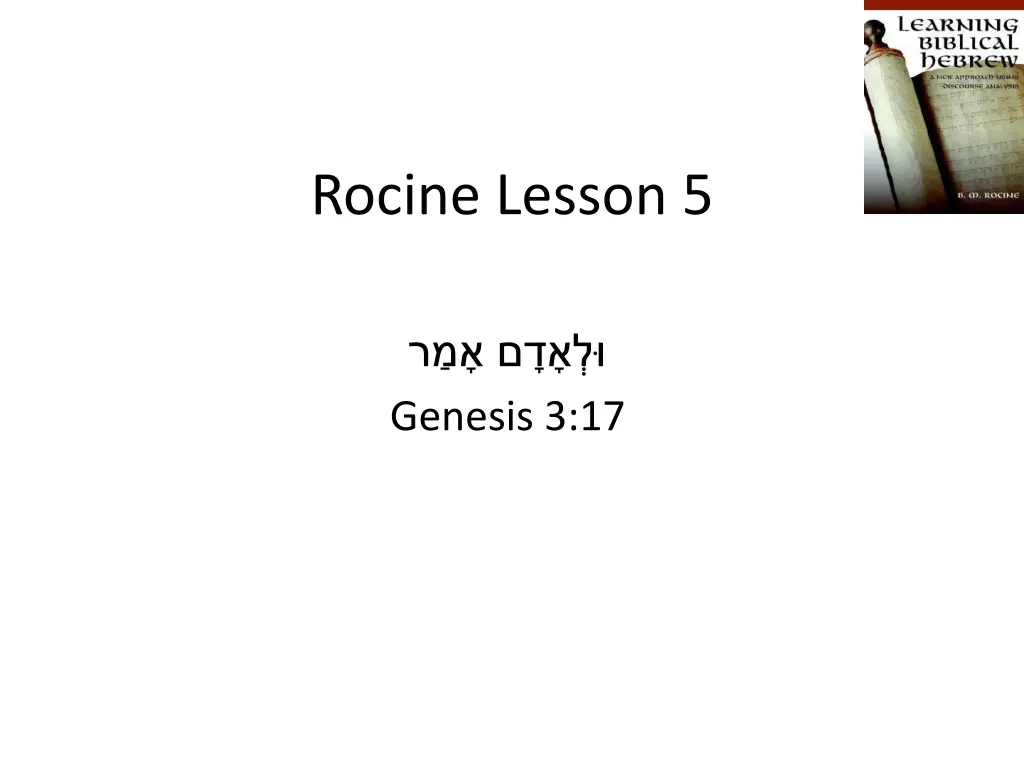
Understanding X-qatal Construction in Genesis 3:17
Explore the significance of X-qatal construction in Hebrew grammar, specifically in Genesis 3:17. Uncover the elements and rules of X-qatal, and learn how to translate and identify this unique word order in historical narratives.
Download Presentation

Please find below an Image/Link to download the presentation.
The content on the website is provided AS IS for your information and personal use only. It may not be sold, licensed, or shared on other websites without obtaining consent from the author. If you encounter any issues during the download, it is possible that the publisher has removed the file from their server.
You are allowed to download the files provided on this website for personal or commercial use, subject to the condition that they are used lawfully. All files are the property of their respective owners.
The content on the website is provided AS IS for your information and personal use only. It may not be sold, licensed, or shared on other websites without obtaining consent from the author.
E N D
Presentation Transcript
Rocine Lesson 5 Genesis 3:17
Goal Identify and read the X-qatal construction.
What we already know We can identify and parse the verb. Person, Gender, Number Root meaning Root Stem Form Function
What we already know We can identify and parse the verb. Person, Gender, Number Root meaning Root Stem Form Function Qal Qatal 3 m s To Be Determined* say * Note The Qatal here is NOT in a dependent clause. (It would need to follow , , or to be in a dependent clause.) Since it is not in a dependent clause, it is NOT fulfilling the function of relative past background.
The significance of the qatal The qatal verb form gives an attribute to the subject of the verb. Translate many of the qatal verb forms which are NOT in a dependent clause as attributions. For your translation, use a gerund (-ing noun) + possessive pronoun. an -er word or E.g. Translation of He was a sayER (of) or His sayING (of)
The significance of the qatal The qatal verb form gives an attribute to the subject of the verb. Translate many of the qatal verb forms which are NOT in a dependent clause as attributions. For your translation, use an -er word or a gerund (-ing noun) + possessive pronoun. E.g. Translation of He was a sayER (of) or His sayING (of) In our verse above (Genesis 3:17) YHWH is speaking to Adam after he has spoken to the serpent and to the woman. Now he turns to address the man, Adam. YHWH, therefore, is the subject of the our verb . According to our rule, then, how would you translate here? Or to put it another way, what attribute of YHWH is being brought into focus here?
X-qatal The word order in our verse is referred to as an X-qatal or sometimes Waw-X-qatal
X-qatal The word order in our verse is referred to as an X-qatal or sometimes Waw-X-qatal What are the elements? The Waw is the Waw. The X is the bit that comes between the waw the verb. The X can be a number of different things, e.g. subject, direct object, indirect object, or a prepositional phrase. The Qatal is the Qatal verb.
X-qatal The word order in our verse is referred to as an X-qatal or sometimes Waw-X-qatal RULE: In Historical Narrative, the X-Qatal has focus-shifting function, called topicalization. It is this unusual word order in Hebrew (something coming before the verb) that signals to the reader that the X component is in focus. We will try to represent that in English with the following construction (also an unusual word order in English) (And) It was X who(that) (Remainder of clause)
X-qatal Using what we have learned, how would you translate our lesson verse (above)? Translation of the qatal in a non-dependent clause: E.g. Translation of He was a sayER (of) or His sayING (of) Translation of the X-Qatal or Waw-X-Qatal construction: (And) It was X who(that) (Remainder of clause) .
X-qatal Using what we have learned, how would you translate our lesson verse (above)? Translation of the qatal in a non-dependent clause: E.g. Translation of He was a sayER (of) or His sayING (of) Translation of the X-Qatal or Waw-X-Qatal construction: (And) It was X who(that) ___(Remainder of clause) . Translation: And it was to Adam that he was a sayer.
What does the X-qatal do? And it was to Adam that he was a sayer. In Historical Narrative the X-qatal does a number of things: Beginning of a discourse Middle of a discourse a summary of what follows a change in focus, e.g. - a switch in time - switch of characters in a story The one word used for all these functions is topicalization. X-qatal = topicalization
What we already know We can now identify the function column of our verb analysis chart from above. Person, Gender, Number Root meaning Root Stem Form Function Qal Qatal 3 m s To Be Determined say
What we already know We can now identify the function column of our verb analysis chart from above. Person, Gender, Number Root meaning Root Stem Form Function X-qatal = topicalization Qal Qatal 3 m s say
Summary Qatal in Historical Narrative QATAL IN QATAL IN DEPENDENT CLAUSES (Lesson 4) INDEPENDENT CLAUSES (Lesson 5) a relative, e.g. any other word or phrase, i.e. an X Preceded by Translate has, had, have (And) it was X who(that) ____ Function in verb analysis chart Qatal in dep. clause = relative past background X-qatal = topicalization Jethro heard all which God had done. Example And it was to Adam that he was a sayer.
Summary of Qatal and Wayyiqtol QATAL IN QATAL IN WAYYIQTOL DEPENDENT CLAUSES (Lesson 4) INDEPENDENT CLAUSES (Lesson 5) (Lessons 1, 2, 3) Preceded by a relative, e.g. any other word or phrase, i.e. an X nothing Translate has, had, have (And) it was who(that) ____ X Usually as an English past tense Function Qatal in dep. clause = relative past background X-qatal = topicalization Historical narrative Mainline Jethro heard all which God had done. YHWH said Example And it was to Adam that he was a sayer. God spoke to Moses and said to him, I am YHWH Moses went and spoke the words to all Israel
Concerning English Bibles Most English translations generally ignore the difference between the qatal and the wayyiqtol verb forms. Genesis 1:1 is a qatal verb form, and translators generally use a simple past translation: In the beginning God created. Genesis 1:3 is a wayyiqtol verb form, and translators use simple past once again: And God said This book, on the other hand, suggests trying to capture the difference in meaning between the qatal and wayyiqtol verb forms: It was in the beginning that God was creator And then God said
Concerning English Bibles The reason we are learning Biblical Hebrew is not to once again translate the Hebrew Bible. Many excellent translations already exist. Rather, we are trying to better understand the nuance of the original language.

